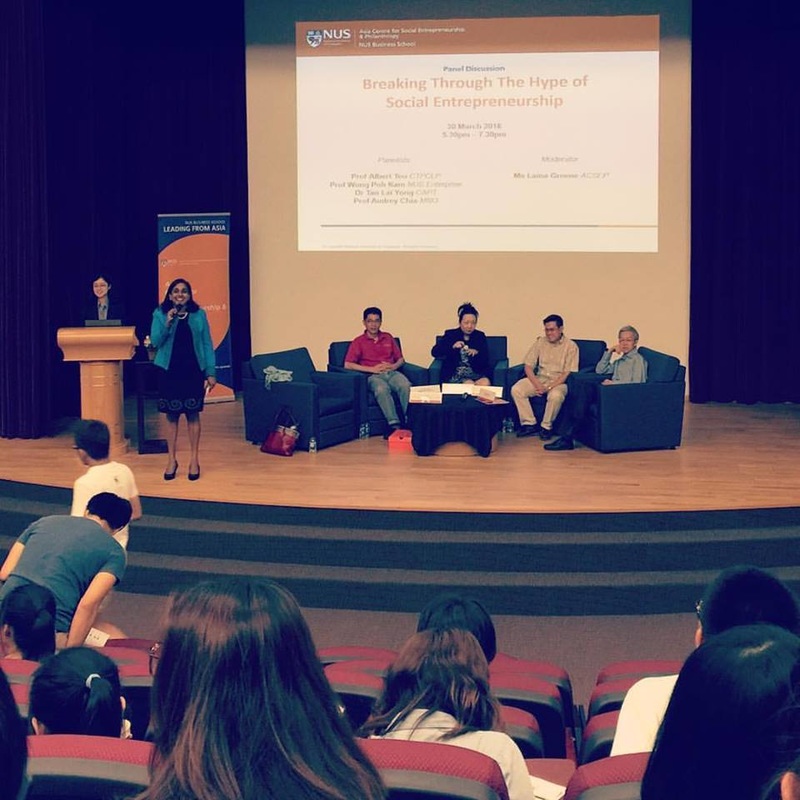|
A great learning experience tonight on the various spectrum of social entrepreneurship and social innovation. Thank you Laina Greene for Organising this with NUS ACSEP. It was an eye opener to hear from each of the professors who shared their own personal story and discovery journeys of their own purpose, how one's purpose can contribute to impact in the world through social businesses or simply learning by doing or by serving in small ways in a community. Despite doing all, it was also so humbling to hear how the professors are on their journey in still discovering their purpose.. The one last thing Prof Wong Poh Kam said with regards to social entrepreneurs, can we social entrepreneurs let go of the work we do, and leave, pass on the foundations they have built to achieve greater social impact. Good food for thought!
Abstract There has been a lot of hype in Singapore about social entrepreneurship, and many are still confused about definitions and which organization qualifies as what. Meanwhile, NUS professors have diligently been offering classes about social entrepreneurship and there is growing interest to learn more about social entrepreneurship on campus. This talk seeks to bring students interested in this field together with these various professors to gain valuable insights into why they are passionate about social entrepreneurship, why and what they teach in their courses and a few lessons they feel students wanting to explore this field must truly understand. This talk is a good continuation to last week’s talk about empathy and human centric design by Acumen+Singapore and Ashoka. These series of talks are the initiative of Laina Greene, Associate Director (Community Development) at the Asia Centre for Social Entrepreneurship & Philanthropy (ACSEP). This is a platform for learning and to gather students into a community interested in social impact and social entrepreneurship. It is also a platform to gather interest in the student body for the upcoming “Crossing the Chasm” Challenge organized as a “consulting style” competition, where students get to assist existing social enterprise in the region and win attractive prizes. Students who help organize this competition, and who participate in this competition will be considered favourably for the NUSBSA Social Impact Prize Award (open to all business school undergrads). About The Speakers Prof Albert Teo is Deputy Director (Student Life) at the University Scholars Programme (USP) and Director of the Chuan Thian Poh Community Leadership Programme. He is also an associate professor in the Department of Management & Organisation at NUS Business School. He served as the founding director of the Centre for Social Entrepreneurship & Philanthropy in the NUS Business School from July 2008 to June 2011. In November 2011, he set up the Chua Thian Poh Community Leadership Programme (CTPCLP) –an undergraduate leadership programme in NUS that focuses on community building and development – where he serves as its director. CTPCLP is based in and supported by the USP. Prof Wong Poh Kam is concurrently a Professor at the School of Business, as well as Director for NUS Entrepreneurship Centre. He has published in numerous international refereed journals on innovation policy, industrial and competitiveness policy and technology entrepreneurship, and has also consulted widely for international agencies such as the World Bank and Asian Development Bank, various government agencies in Singapore such as A*STAR, EDB and IDA, and many high tech firms in Asia. His passion is social enterprise development and he is the founder of the DBS-NUS Social Venture Challenge Asia. Dr Tan Lai Yong is a Fellow at the College of Peter and Alice Tan. In 1996, Dr Tan as a medical doctor and his wife, and one year old daughter moved to Yunnan, China, and joined a community development team, working with the poverty affected in remote villages, caring for orphans, disabled children and leprosy affected. in 2004, he was given the Friendship Award for Foreign Experts in Beijing, in 2005 the SIF Award and in 2005 the MILK Award. In 2007, the Yunnan Provincial TV viewers voted him as one of the “Good Citizens of Kunming and he has written several books. Ms Laina Greene is Associate Director (Community Development) at ACSEP and Senior Adjunct Lecturer at Policy and Strategy Department of NUS Business School. She is also founder of GetIT, Inc in California which incubates tech for good startups and invests into social enterprises. She has worked and travelled to more than 30 countries around the world, has worked as Senior Advisor to Ashoka Indonesia, and is currently Global Ambassador of Unltd Indonesia and Advisor to Acumen+Singapore. About ACSEP The vision of the Asia Centre for Social Entrepreneurship & Philanthropy (ACSEP) is to advance understanding and impactful practice of social entrepreneurship and philanthropy throughout Asia through research and education. Being a resource and knowledge hub, we aim to bridge those who have the ability and desire to do good and with those in need. ACSEP is launching a new “consultancy style” competition called “Crossing the Chasm” Challenge in October 2016 (call for applications will be announced at the other signature event ISSE 2016 on 22 April 2016). Come and learn more about this new upcoming event and about the Social Impact Prize. Victory of the People by Muhammad Yunus
Oxfam Updates on Wealth Concentration Oxfam has been giving us horrifying updates on wealth concentration each year. This year they tell us that 62 richest people own more wealth than owned by bottom half of world population. In 2015 they reported that the 80 richest people, and in 2014, according to them 85 richest people owned more wealth than owned by the bottom half of world population. In 2010, six years back, it was 388 richest people who had the pleasure of owning similar wealth. They also told us that wealth of 80 richest people doubled in five years, between 2009 and 2014. Oxfam has a terrifying projection for 2016. During the current year, they projected, the richest 1% of the world will own 99% of the world's wealth. That means 99% of the people will be left with only 1% of the wealth. This information is so unbelievable that it takes time to absorb. We feel like asking many more questions. How many of world's richest people will own more wealth than owned by the bottom half of the world population, say, in 2025? It is obvious that if the number can drop from 388 persons to 62 persons in six years we are just one small step away from one lucky person owning more wealth than owned by bottom half of the world population! US presidential candidate Bernie Sanders keeps reminding in his campaign speeches that in the USA, the top 0.1% owns 90% of the nation's wealth. What about Bangladesh? Is it 62, or more, or less, of the richest owning more wealth than owned by the bottom half of the country's population? Does it interest anyone to find the number? How long will it take to reach a point where only one person will own more wealth than owned by bottom half of the people of Bangladesh? Obviously he will be the 'King'. His wishes will be the law of the land. Does it sound too far-fetched? Concentration of wealth also means concentration of power -- political and social, privileges, and opportunities. The reverse is also true. If you don't have any wealth, you have no power, no privileges, no opportunities. The bottom fifty percent of the people of the world who own only a tiny fraction of 1% of the global wealth, belong to this category. Tomorrow it will be worse. Concentration is an ongoing non-stop process under the present economic system. That's the point I am drawing your attention to the richest people are not necessarily bad people, as popularly imagined, engineering the ever-expanding concentration of wealth with bad intentions. It is the system which does it for them. Wealth is like a magnet. The bigger the magnet the greater is its pulling force. It draws smaller magnets towards it. That's how the economic system is built. People with no magnet find it difficult to attract anything to them. If they somehow own some tiny magnets, retaining them becomes difficult for them. Bigger ones pull them to themselves. Unidirectional forces of concentration of wealth keep changing the shape of wealth-pyramid making its base thinner and its peak narrower and higher, ultimately looking like a thinning column rising out of a thin but large base. (Delivered at the 25th Anniversary event of the Daily Star on February 5, 2016 in Dhaka.) For full speech: http://www.muhammadyunus.org/index.php/news-media/speeches/1522-can-wealth-concentration-be-stopped-speech |
Angels of Impact A.I.Receive thought leadership, news, updates and events activities Archives
July 2017
Categories |


 RSS Feed
RSS Feed